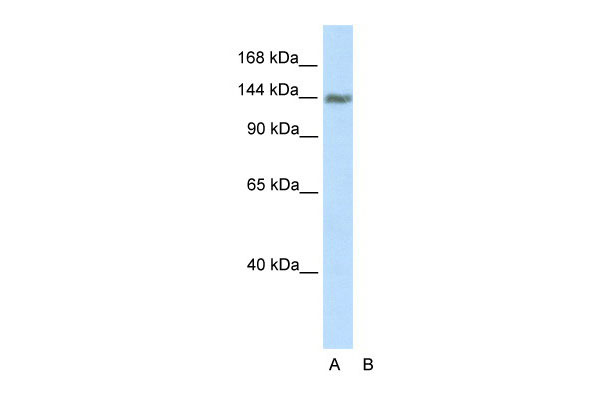TIMELESS antibody - C-terminal region
Rabbit Polyclonal Antibody
- 产品详情
- 实验流程
Application
| WB |
|---|---|
| Primary Accession | Q9UNS1 |
| Other Accession | NM_003920, NP_003911 |
| Reactivity | Human, Mouse, Rat, Dog, Horse, Bovine, Sheep, Yeast |
| Predicted | Human, Bovine |
| Host | Rabbit |
| Clonality | Polyclonal |
| Calculated MW | 138658 Da |
| Gene ID | 8914 |
|---|---|
| Alias Symbol | TIM, TIM1, hTIM |
| Other Names | Protein timeless homolog, hTIM, TIMELESS {ECO:0000312|EMBL:AAH50557.1} |
| Format | Liquid. Purified antibody supplied in 1x PBS buffer with 0.09% (w/v) sodium azide and 2% sucrose. |
| Reconstitution & Storage | Add 100 ul of distilled water. Final anti-TIMELESS antibody concentration is 1 mg/ml in PBS buffer with 2% sucrose. For longer periods of storage, store at 20°C. Avoid repeat freeze-thaw cycles. |
| Precautions | TIMELESS antibody - C-terminal region is for research use only and not for use in diagnostic or therapeutic procedures. |
| Name | TIMELESS {ECO:0000312|EMBL:AAH50557.1} |
|---|---|
| Function | Plays an important role in the control of DNA replication, maintenance of replication fork stability, maintenance of genome stability throughout normal DNA replication, DNA repair and in the regulation of the circadian clock (PubMed:17141802, PubMed:17296725, PubMed:23359676, PubMed:23418588, PubMed:26344098, PubMed:31138685, PubMed:32705708, PubMed:35585232, PubMed:9856465). Required to stabilize replication forks during DNA replication by forming a complex with TIPIN: this complex regulates DNA replication processes under both normal and stress conditions, stabilizes replication forks and influences both CHEK1 phosphorylation and the intra-S phase checkpoint in response to genotoxic stress (PubMed:17141802, PubMed:17296725, PubMed:23359676, PubMed:35585232). During DNA replication, inhibits the CMG complex ATPase activity and activates DNA polymerases catalytic activities, coupling DNA unwinding and DNA synthesis (PubMed:23359676). TIMELESS promotes TIPIN nuclear localization (PubMed:17141802, PubMed:17296725). Plays a role in maintaining processive DNA replication past genomic guanine-rich DNA sequences that form G- quadruplex (G4) structures, possibly together with DDX1 (PubMed:32705708). Involved in cell survival after DNA damage or replication stress by promoting DNA repair (PubMed:17141802, PubMed:17296725, PubMed:26344098, PubMed:30356214). In response to double-strand breaks (DSBs), accumulates at DNA damage sites and promotes homologous recombination repair via its interaction with PARP1 (PubMed:26344098, PubMed:30356214, PubMed:31138685). May be specifically required for the ATR-CHEK1 pathway in the replication checkpoint induced by hydroxyurea or ultraviolet light (PubMed:15798197). Involved in the determination of period length and in the DNA damage-dependent phase advancing of the circadian clock (PubMed:23418588, PubMed:31138685). Negatively regulates CLOCK|NPAS2- ARTNL/BMAL1|ARTNL2/BMAL2-induced transactivation of PER1 possibly via translocation of PER1 into the nucleus (PubMed:31138685, PubMed:9856465). May play a role as destabilizer of the PER2-CRY2 complex (PubMed:31138685). May also play an important role in epithelial cell morphogenesis and formation of branching tubules (By similarity). |
| Cellular Location | Nucleus. Chromosome Note=In response to double-strand breaks (DSBs), accumulates at DNA damage sites via its interaction with PARP1 |
| Tissue Location | Expressed in all tissues examined including brain, heart, lung, liver, skeletal muscle, kidney, placenta, pancreas, spleen, thymus and testis. Highest levels of expression in placenta, pancreas, thymus and testis. |
Research Areas
For Research Use Only. Not For Use In Diagnostic Procedures.
Application Protocols
Provided below are standard protocols that you may find useful for product applications.
REFERENCES
Sangoram,A.M., (2005) Mol. Cell. Biol. 25 (8), 3109-3116Reconstitution and Storage:For short term use, store at 2-8C up to 1 week. For long term storage, store at -20C in small aliquots to prevent freeze-thaw cycles.
终于等到您。ABCEPTA(百远生物)抗体产品。
点击下方“我要评价 ”按钮提交您的反馈信息,您的反馈和评价是我们最宝贵的财富之一,
我们将在1-3个工作日内处理您的反馈信息。
如有疑问,联系:0512-88856768 tech-china@abcepta.com.























 癌症的基本特征包括细胞增殖、血管生成、迁移、凋亡逃避机制和细胞永生等。找到癌症发生过程中这些通路的关键标记物和对应的抗体用于检测至关重要。
癌症的基本特征包括细胞增殖、血管生成、迁移、凋亡逃避机制和细胞永生等。找到癌症发生过程中这些通路的关键标记物和对应的抗体用于检测至关重要。 为您推荐一个泛素化位点预测神器——泛素化分析工具,可以为您的蛋白的泛素化位点作出预测和评分。
为您推荐一个泛素化位点预测神器——泛素化分析工具,可以为您的蛋白的泛素化位点作出预测和评分。 细胞自噬受体图形绘图工具为你的蛋白的细胞受体结合位点作出预测和评分,识别结合到自噬通路中的蛋白是非常重要的,便于让我们理解自噬在正常生理、病理过程中的作用,如发育、细胞分化、神经退化性疾病、压力条件下、感染和癌症。
细胞自噬受体图形绘图工具为你的蛋白的细胞受体结合位点作出预测和评分,识别结合到自噬通路中的蛋白是非常重要的,便于让我们理解自噬在正常生理、病理过程中的作用,如发育、细胞分化、神经退化性疾病、压力条件下、感染和癌症。






